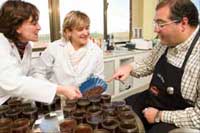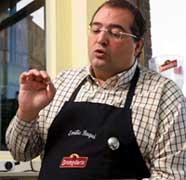Spain: the growth of the coffee sector passes through training and the culture of the product
By Carlo Odello
We speak about the Spanish coffee market with Emilio Baqué Delás. Baqué is one of the greatest experts of this market. Indeed, apart from being the vice-president of the Spanish Association of Coffee Roasters, his is managing director of Grupo Café Dromedario – Cafés La Brasileña (approximately €24m turnover with a production of 3000 tons of roasted coffee per year). He is, in addition, president of the Comercial de Materia Primas, the second biggest green coffee importer in Spain, owner of 13 roasters in the country.
Can you describe the Spanish coffee market?
 In Spain there are approximately 250-300 coffee roasters of which 130 are members of the Spanish Association of Coffee Roasters and of the Spanish Federation for Coffee. Over the last decade the process of concentration of companies has accelerated and this will carry on in future years. There will be a significant reduction of the number of companies for several reasons: many are family run businesses with the related succession problems, the greater difficulties at an operational commercial level (coffee machines, funding for shops and so on), the fact that some companies are after volume and that some others lack professionalism.
In Spain there are approximately 250-300 coffee roasters of which 130 are members of the Spanish Association of Coffee Roasters and of the Spanish Federation for Coffee. Over the last decade the process of concentration of companies has accelerated and this will carry on in future years. There will be a significant reduction of the number of companies for several reasons: many are family run businesses with the related succession problems, the greater difficulties at an operational commercial level (coffee machines, funding for shops and so on), the fact that some companies are after volume and that some others lack professionalism.
If we want to identify the major brands, we should distinguish between those that operate in the market for both consumption at home and horeca and those that focus on horeca only. The home market is in the hands of three multinationals – Nestlé, Kraft and Sara Lee – and some brands of big distribution chains such as Carrefour, Mercadona, Eroski and others. The multinationals and big distribution chains account for 90% of the market. Then there a number of roasters that operate at a regional level, however, they are no more than 30. The latter, alongside many other roasters, are present also on the horeca market in which no brand goes any higher than a 10% market share. The regional or local brand is fine for the horeca market.
How about consumers?
The Spanish consumers do not have a real culture of coffee. It is not their fault: the coffee sector in general, from the roasters to the machines manufacturers, has never had a culture of coffee. The explanation for this lack of knowledge is to be found in the history of our country. Till 1977, the State strictly controlled coffee trade. The State was the exporter of green coffee and defined the sale price to the roasters and the price of the roasted product of which there were only three categories: Superior, Corriente, Popular. The criterion applied by the State had more to do with volumes and the price to the end consumer rather than with quality. The roasters roasted what they were given by the State and had no access to the wondrous world of species, origins and blends.
After the liberalisation, at the end of the ‘70s, the change process has been difficult and slow: the roasters learned little by little thank to the generational change in the companies, some of them started to invest in training of the sellers and of the consumers and coffee shops started becoming popular.
Still today, however, many consumers see coffee as simple food and believe that all the coffee comes from Columbia on the back of Juan Valdez’s mule. These are the consumers of coffee with milk served in a crystal glass, those who defend the torrefacto, the coffee roasted with sugar added to it, these are the consumers who still believe in old clichés. In other words, they are those from the past.
There is an increasing number of consumers who have grater knowledge and want to chose, who look for a specific origin or for a blend of coffee with a majority percentage of Arabica, who abandon the torrefacto for naturally roasted coffees, which is to say, simply roasted without adding any sugar. Nonetheless, there is still a long way to come.
Let’s talk about the barista: what is their level of professionalism?
 In Spain, there has been a time when the most experienced person at the bar automatically became the barista. This was the person in charge of the coffee machine, of its maintenance and of taking care of it. All this is history which dates back to decades ago. In the years of the economic crisis many sought refuge in the horeca and the average level of professionalism of the barista dropped. Luckily enough the specialised schools have been able to make up in part for this gap over the last few years. The level of professionalism improves as long as the roasters cooperate in the training activity in these schools.
In Spain, there has been a time when the most experienced person at the bar automatically became the barista. This was the person in charge of the coffee machine, of its maintenance and of taking care of it. All this is history which dates back to decades ago. In the years of the economic crisis many sought refuge in the horeca and the average level of professionalism of the barista dropped. Luckily enough the specialised schools have been able to make up in part for this gap over the last few years. The level of professionalism improves as long as the roasters cooperate in the training activity in these schools.
The new problem of the Spanish horeca is that nowadays the country has an unprecedented life style and the horeca workers tend to leave to go in more comfortable sectors. This is the reason why there are increasingly high numbers of immigrants doing this job with very little training and with very high turn-over. Curiously enough, this is happening in a time when the Forum Cultural del Café, a non-profit organisation founded to promote the culture of coffee in Spain, and the member roasters are launching more and more competitions between baristas, training courses and events dedicated to them. The last two winners of the barista championship organised by the Forum Cultural del Café come from Peru and from Morocco. This shows that focusing on training for the barista, despite being difficult, is fruitful.
To conclude: in your view, what is the future of the Spanish market?
Spain is a country which must still come a long way in order to improve its cup of coffee. This is an effort that the sector must make in the next few years. The average coffee consumption in our country is of 4 kg of green per head per year, which means that we are the tail ender in Europe. If we keep working on training consumers, if we keep promoting the culture of the barista in the horeca too, if we keep caring about the offer of the product to the consumer – with more coffee shops, with more specialised shops, with a broader product range – if we do not let go on this and if we do not start looking for a short-term benefit, then we might as well take this market up to higher numbers. This is the incentive for those who do my job.
 What does the coffee market in the UK look like?
What does the coffee market in the UK look like?
